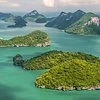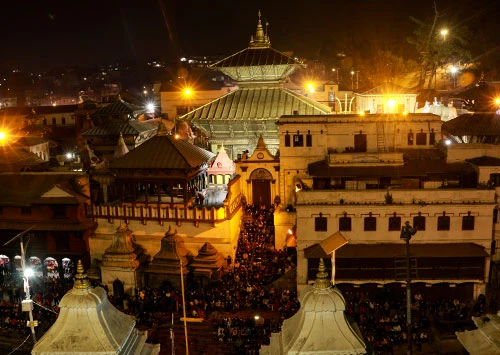Nepal Hindu Pilgrimage Tour – Highlights
- Pashupatinath Temple (Kathmandu): Sacred Shiva temple, UNESCO World Heritage Site.
- Guhyeshwari Temple: Important Shakti Peetha near Pashupatinath.
- Budhanilkantha: Sleeping Vishnu statue in an open-air pool.
- Manakamana Temple: Wish-fulfilling goddess, accessed by cable car.
- Muktinath Temple (Mustang): Sacred site for both Hindus and Buddhists, known for 108 water spouts.
- Janakpur: Birthplace of Sita and site of the grand Janaki Mandir.
- Doleshwar Mahadev (Bhaktapur): Believed to be the head of Kedarnath.
- Devghat: Confluence of holy rivers, popular for rituals and meditation.
Nepal Hindu pilgrimage tour overview!
A Nepal Hindu pilgrimage tour can be a deeply spiritual and culturally enriching experience, as it involves visiting sacred sites and temples associated with Hinduism. Nepal, a land rich in diverse cultures and home to various religious faiths such as Hinduism, Christianity, Islam, and Buddhism, offers a multitude of travel options for those seeking religious pilgrimage destinations. Himalayan Joy Adventure presents pilgrimage tour packages and Hindu Circuit tour packages in Nepal, catering to devotees eager to offer prayers to the divine. These comprehensive Hindu pilgrimage packages promise ultimate peace and a profound spiritual experience.
The Hindu Circuit Tour provided by Himalayan Joy encompasses all the major sacred sites in Nepal, each holding significant spiritual importance. The Nepal Hindu Spiritual tour package includes visits to revered places such as Pashupatinath, Swayambhunath, Barah Chhetri, Budha Nilkhanth, Manakamana temple, Mahadev temple, Janaki Mandir, Ram Mandir, Balmiki Asram, and more. Each of these sacred locations is intertwined with legends that celebrate the power of the respective deity. Hindu devotees from Nepal, India, and Sri Lanka converge upon these temples during special occasions and major festivals.
Pashupatinath Temple (Kathmandu): Pashupatinath is one of the most sacred Hindu temples dedicated to Lord Shiva, located on the banks of the Bagmati River in Kathmandu. The temple complex is a UNESCO World Heritage Site and includes numerous shrines, ashrams, and inscriptions. It is considered the holiest Shiva temple in Nepal and one of the most important pilgrimage sites in the entire Hindu world. Devotees believe visiting Pashupatinath and dying on its premises guarantees liberation (moksha) from the cycle of rebirth.
Guhyeshwari Temple (Kathmandu); Located near Pashupatinath, Guhyeshwari Temple is dedicated to Goddess Parvati and is one of the Shakti Peethas — sacred abodes of the Divine Feminine. The temple is revered by both Hindus and Buddhists. It is believed to mark the spot where the yoni (reproductive organ) of Goddess Sati fell after her body was dismembered by Lord Vishnu. It symbolizes feminine creative power (Shakti).
Budhanilkantha Temple (Kathmandu): Budhanilkantha houses a large reclining statue of Lord Vishnu resting on a bed of serpents (Sheshnag) in a pond. The statue is carved from a single block of black basalt. It is one of the most important Vishnu shrines in Nepal. The idol appears to be floating on water, and the site is venerated for its miraculous and mysterious qualities. Kings of Nepal traditionally do not visit the temple due to a prophecy related to death.
Manakamana Temple (Gorkha): Manakamana Temple is a sacred shrine of Goddess Bhagwati, an incarnation of Parvati, located atop a hill in the Gorkha district. It is accessible by cable car or foot trail. "Manakamana" means "wishes of the heart." It is believed that sincere wishes made at this temple are fulfilled. Pilgrims come to seek blessings for health, prosperity, and success.
Muktinath Temple (Mustang): Situated at an altitude of 3,710 meters in the Mustang district, Muktinath is a sacred temple dedicated to Lord Vishnu and also revered in Buddhism.
"Muktinath" means "Lord of Liberation." The temple is one of the 108 Vaishnava Divya Desams and is also sacred to Tibetan Buddhists. Pilgrims believe bathing in the 108 stone spouts at the temple absolves all sins and grants salvation.
Janakpur (Janaki Temple): Janakpur is the birthplace of Goddess Sita (Janaki), the consort of Lord Rama. The Janaki Temple is an ornate marble structure built in the 19th century. A major pilgrimage site for Hindus, especially during festivals like Vivah Panchami, which celebrates the marriage of Sita and Rama. The temple is deeply rooted in the Ramayana and attracts devotees from India and Nepal alike.
Doleshwar Mahadev (Bhaktapur): Located in Bhaktapur, Doleshwar Mahadev is a temple dedicated to Lord Shiva and is believed to be the head part of the Kedarnath deity in India. Recognized by Indian priests from Kedarnath in 2009, the temple has gained religious prominence. Pilgrims believe that visiting Doleshwar completes the Kedarnath pilgrimage spiritually, especially for those who cannot travel to Uttarakhand.
Devghat (Chitwan-Tanahun border): Devghat is a sacred confluence of the Kali Gandaki and Trishuli rivers. It is dotted with temples, hermitages, and ashrams, and is a popular site for holy dips and rituals. Regarded as a sacred site for ancestral rituals (shraddha) and a spiritual retirement place for sages and saints. It is believed that a dip here cleanses sins and aids in attaining moksha. The area is vibrant during Makar Sankranti.
For devotees seeking a religious vacation in Nepal, the Hindu Tour package presents an ideal choice. It encompasses all the significant pilgrimage destinations in Nepal, ranging from ancient to medieval to modern temples. We are dedicated to assisting and planning your pilgrimage tour at the most competitive prices.
Nepal Hindu Pilgrimage tour best time
The best time for a Hindu pilgrimage tour in Nepal is during the Spring (March to May) and autumn (September to November) seasons. These months offer pleasant weather, clear skies, and comfortable temperatures, ideal for visiting sacred sites like Pashupatinath Temple, Muktinath, and Gosaikunda Lake. Avoid the monsoon season (June to August) due to heavy rains and slippery trails. Winter (December to February) can be cold, especially in higher altitudes, but still suitable for lowland pilgrimages.
Nepal Hindu Pilgrimage tour difficulty level
The Nepal Hindu Pilgrimage Tour is generally easy to moderate in difficulty, suitable for most travelers with basic fitness. It involves visiting temples and sacred sites, often with some walking on uneven paths but no strenuous trekking.
Nepal Hindu Pilgrimage Tour Packing List, Gears, and Equipment
Here's the Nepal Hindu Pilgrimage Tour Packing List, Gear, and Equipment.
Clothing
- Lightweight cotton shirts/tunics (modest and comfortable)
- Long pants or traditional dhoti/sari (depending on preference)
- Comfortable walking shoes or sandals (preferably waterproof)
- Warm jacket or fleece (for cooler evenings/mountains)
- Raincoat or poncho (monsoon season)
- Scarf or shawl (for temple visits)
- Socks (breathable and quick-dry)
- Hat or cap (sun protection)
- Sleepwear
Personal Items
- Passport, visa, and travel documents
- Photocopies of important documents
- Local currency (Nepalese Rupees) and small change
- Travel insurance information
- Phone and charger
- Power bank
- Personal identification (ID card, driver’s license)
- Reusable water bottle (preferably with a filter)
Religious Items
- Small prayer book or scripture
- Puja items (incense sticks, small oil lamp, flowers)
- Mala beads or rosary
- Offering money or donations
- Small backpack or bag for temple offerings
Toiletries & Health
- Toothbrush and toothpaste
- Soap and shampoo (travel size)
- Hand sanitizer
- Sunscreen (high SPF)
- Insect repellent
- Basic first aid kit (band-aids, antiseptic, painkillers)
- Prescription medications (if any)
- Tissues or wet wipes
- Lip balm
- Contact lenses and solution (if applicable)
Gears & Equipment
- Comfortable backpack (with rain cover)
- Daypack for short temple visits
- Trekking poles (optional, if trekking is involved)
- A camera or a smartphone for photos
- Travel adapter and charger
- Flashlight or headlamp
- Ziplock bags for keeping items dry
- Sunglasses
- Notebook and pen (for journaling)
Optional Extras
- Travel pillow
- Snacks (energy bars, nuts)
- Guidebook or map of pilgrimage sites
- Small towel or handkerchief
- Portable seat mat for temple seating






